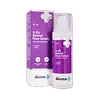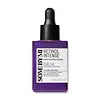What's inside
What's inside
 Key Ingredients
Key Ingredients

 Benefits
Benefits

 Concerns
Concerns

 Ingredients Side-by-side
Ingredients Side-by-side

Water
Skin ConditioningEthylhexyl Methoxycrylene
Skin ConditioningDiethylhexyl Carbonate
EmollientEthoxydiglycol
HumectantGlycerin
HumectantTetrahexyldecyl Ascorbate
AntioxidantDimethylmethoxy Chromanol
AntioxidantPhysalis Angulata Extract
Skin ProtectingCaprylic/Capric Triglyceride
MaskingCyclopentasiloxane
EmollientPhenyl Trimethicone
Skin ConditioningDimethiconol
EmollientC12-15 Alkyl Benzoate
AntimicrobialDimethicone Crosspolymer
Emulsion StabilisingHydroxyethyl Acrylate/Sodium Acryloyldimethyl Taurate Copolymer
Emulsion StabilisingPhenoxyethanol
PreservativeEthylhexylglycerin
Skin ConditioningMethyl Glucose Sesquistearate
EmollientBehenyl Alcohol
EmollientTrisodium Ethylenediamine Disuccinate
Pentylene Glycol
Skin Conditioning4-T-Butylcyclohexanol
MaskingPentaerythrityl Distearate
EmulsifyingBHT
AntioxidantRetinol
Skin ConditioningPolysorbate 20
EmulsifyingSodium Metabisulfite
AntioxidantWater, Ethylhexyl Methoxycrylene, Diethylhexyl Carbonate, Ethoxydiglycol, Glycerin, Tetrahexyldecyl Ascorbate, Dimethylmethoxy Chromanol, Physalis Angulata Extract, Caprylic/Capric Triglyceride, Cyclopentasiloxane, Phenyl Trimethicone, Dimethiconol, C12-15 Alkyl Benzoate, Dimethicone Crosspolymer, Hydroxyethyl Acrylate/Sodium Acryloyldimethyl Taurate Copolymer, Phenoxyethanol, Ethylhexylglycerin, Methyl Glucose Sesquistearate, Behenyl Alcohol, Trisodium Ethylenediamine Disuccinate, Pentylene Glycol, 4-T-Butylcyclohexanol, Pentaerythrityl Distearate, BHT, Retinol, Polysorbate 20, Sodium Metabisulfite
Water
Skin ConditioningCyclohexasiloxane
EmollientDicaprylyl Carbonate
EmollientGlycerin
HumectantMethylpropanediol
Solvent1,2-Hexanediol
Skin ConditioningNiacinamide
SmoothingHydrogenated Poly(C6-14 Olefin)
EmollientPanthenol
Skin ConditioningTocopheryl Acetate
AntioxidantPiper Methysticum Leaf/Root/Stem Extract
Skin ConditioningCentella Asiatica Extract
CleansingPanax Ginseng Berry Extract
Skin ConditioningGlycyrrhiza Glabra Root Extract
BleachingFicus Carica Fruit Extract
HumectantCentella Asiatica Leaf Extract
Skin ConditioningCentella Asiatica Root Extract
Skin ConditioningMelaleuca Alternifolia Leaf Extract
PerfumingArtemisia Capillaris Extract
Eclipta Prostrata Extract
Skin ConditioningMelia Azadirachta Leaf Extract
Skin ConditioningElaeis Guineensis Oil
EmollientHydrogenated Lecithin
EmulsifyingGlyceryl Stearate
EmollientBakuchiol
AntimicrobialPalmitic Acid
EmollientSodium Polyacrylate
AbsorbentStearic Acid
CleansingXanthan Gum
EmulsifyingRetinol 0.1%
Skin ConditioningAcrylates/C10-30 Alkyl Acrylate Crosspolymer
Emulsion StabilisingButylene Glycol
HumectantDipotassium Glycyrrhizate
HumectantAdenosine
Skin ConditioningTromethamine
BufferingPolyquaternium-51
Skin ConditioningBeta-Glucan
Skin ConditioningCetyl Alcohol
EmollientBHT
AntioxidantCollagen
MoisturisingMyristic Acid
CleansingBHA
AntioxidantLeuconostoc/Radish Root Ferment Filtrate
AntimicrobialTocopherol
AntioxidantBifida Ferment Lysate
Skin ConditioningCeramide NP
Skin ConditioningSaccharomyces Ferment
Skin ConditioningRetinal
Skin ConditioningAsiaticoside
AntioxidantGlyceryl Polymethacrylate
Madecassoside
AntioxidantPropylene Glycol
HumectantPolyglyceryl-10 Oleate
Skin ConditioningGlycolipids
Skin ConditioningGlycine Soja Peptide
Skin ConditioningResveratrol
AntioxidantSucrose Distearate
EmollientAsiatic Acid
Skin ConditioningMadecassic Acid
Skin ConditioningPalmitoyl Tripeptide-1
Skin ConditioningMoringa Oleifera Seed Oil
EmollientPEG-100 Stearate
Polysorbate 20
EmulsifyingParfum
MaskingEthylhexylglycerin
Skin ConditioningWater, Cyclohexasiloxane, Dicaprylyl Carbonate, Glycerin, Methylpropanediol, 1,2-Hexanediol, Niacinamide, Hydrogenated Poly(C6-14 Olefin), Panthenol, Tocopheryl Acetate, Piper Methysticum Leaf/Root/Stem Extract, Centella Asiatica Extract, Panax Ginseng Berry Extract, Glycyrrhiza Glabra Root Extract, Ficus Carica Fruit Extract, Centella Asiatica Leaf Extract, Centella Asiatica Root Extract, Melaleuca Alternifolia Leaf Extract, Artemisia Capillaris Extract, Eclipta Prostrata Extract, Melia Azadirachta Leaf Extract, Elaeis Guineensis Oil, Hydrogenated Lecithin, Glyceryl Stearate, Bakuchiol, Palmitic Acid, Sodium Polyacrylate, Stearic Acid, Xanthan Gum, Retinol 0.1%, Acrylates/C10-30 Alkyl Acrylate Crosspolymer, Butylene Glycol, Dipotassium Glycyrrhizate, Adenosine, Tromethamine, Polyquaternium-51, Beta-Glucan, Cetyl Alcohol, BHT, Collagen, Myristic Acid, BHA, Leuconostoc/Radish Root Ferment Filtrate, Tocopherol, Bifida Ferment Lysate, Ceramide NP, Saccharomyces Ferment, Retinal, Asiaticoside, Glyceryl Polymethacrylate, Madecassoside, Propylene Glycol, Polyglyceryl-10 Oleate, Glycolipids, Glycine Soja Peptide, Resveratrol, Sucrose Distearate, Asiatic Acid, Madecassic Acid, Palmitoyl Tripeptide-1, Moringa Oleifera Seed Oil, PEG-100 Stearate, Polysorbate 20, Parfum, Ethylhexylglycerin
 Reviews
Reviews

Ingredients Explained
These ingredients are found in both products.
Ingredients higher up in an ingredient list are typically present in a larger amount.
BHT is a synthetic antioxidant and preservative.
As an antioxidant, it helps your body fight off free-radicals. Free-radicals are molecules that may damage your skin cells.
As a preservative, it is used to stabilize products and prevent them from degrading. Specifically, BHT prevents degradation from oxidation.
The concerns related to BHT come from oral studies; this ingredient is currently allowed for use by both the FDA and EU.
However, it was recently restricted for use in the UK as of April 2024.
Learn more about BHTEthylhexylglycerin (we can't pronounce this either) is commonly used as a preservative and skin softener. It is derived from glyceryl.
You might see Ethylhexylglycerin often paired with other preservatives such as phenoxyethanol. Ethylhexylglycerin has been found to increase the effectiveness of these other preservatives.
Glycerin is already naturally found in your skin. It helps moisturize and protect your skin.
A study from 2016 found glycerin to be more effective as a humectant than AHAs and hyaluronic acid.
As a humectant, it helps the skin stay hydrated by pulling moisture to your skin. The low molecular weight of glycerin allows it to pull moisture into the deeper layers of your skin.
Hydrated skin improves your skin barrier; Your skin barrier helps protect against irritants and bacteria.
Glycerin has also been found to have antimicrobial and antiviral properties. Due to these properties, glycerin is often used in wound and burn treatments.
In cosmetics, glycerin is usually derived from plants such as soybean or palm. However, it can also be sourced from animals, such as tallow or animal fat.
This ingredient is organic, colorless, odorless, and non-toxic.
Glycerin is the name for this ingredient in American English. British English uses Glycerol/Glycerine.
Learn more about GlycerinPolysorbate 20 is made by combining ethoxylation of sorbitan, ethylene oxide, and lauric acid. It is a mild cleansing agent, surfactant, and emulsifier.
As a surfactant, it helps collect dirt and oils for washing. Emulsifiers prevent oils and water from separating.
Polysorbate 20 also adds scent to a product. Since it is made using sorbitol, it has a sweet scent. Sorbitol can also be found in fruits such as apples and peaches.
The lauric acid used to create Polysorbate 20 is often derived from coconuts.
Polysorbate 20 may not be fungal acne safe.
Learn more about Polysorbate 20Retinol is a gold-standard ingredient for anti-aging. It is a form of Vitamin A and belongs to the class of retinoids that also includes tretinoin.
Why is retinol famous?
It has the most scientific studies backing up its skin benefits out of all the non-prescription ingredients.
Retinol is proven to:
This is why retinol is effective at removing wrinkles, fading dark spots, treating acne, and reducing the appearance of pores.
Studies show retinol is less effective when exposed to UV. Be sure to look for appropriate packaging to keep your retinol potent (similar to Vitamin C).
Using retinol or any retinoids will increase sun-sensitivity in the first few months. Though studies show retinoids increase your skin's natural SPF with continuous use, it is best to always wear sunscreen and sun-protection.
We recommend speaking with a medical professional about using this ingredient during pregnancy.
Retinol may cause irritation in some people, so be sure to patch test. Experts recommend 'ramping up' retinol use: start using this ingredient once a week and work up to using it daily.
Read about Tretinoin
Learn more about RetinolWater. It's the most common cosmetic ingredient of all. You'll usually see it at the top of ingredient lists, meaning that it makes up the largest part of the product.
So why is it so popular? Water most often acts as a solvent - this means that it helps dissolve other ingredients into the formulation.
You'll also recognize water as that liquid we all need to stay alive. If you see this, drink a glass of water. Stay hydrated!
Learn more about Water